ZHCSF57 June 2016 TPS51200-EP
PRODUCTION DATA.
- 1 特性
- 2 应用范围
- 3 说明
- 4 修订历史记录
- 5 Pin Configuration and Functions
- 6 Specifications
-
7 Detailed Description
- 7.1 Overview
- 7.2 Functional Block Diagram
- 7.3
Feature Description
- 7.3.1 Sink and Source Regulator (VO Pin)
- 7.3.2 Reference Input (REFIN Pin)
- 7.3.3 Reference Output (REFOUT Pin)
- 7.3.4 Soft-Start Sequencing
- 7.3.5 Enable Control (EN Pin)
- 7.3.6 Powergood Function (PGOOD Pin)
- 7.3.7 Current Protection (VO Pin)
- 7.3.8 UVLO Protection (VIN Pin)
- 7.3.9 Thermal Shutdown
- 7.3.10 Tracking Start-up and Shutdown
- 7.4 Device Functional Modes
- 8 Application and Implementation
- 9 Power Supply Recommendations
- 10Layout
- 11器件和文档支持
- 12机械、封装和可订购信息
6 Specifications
6.1 Absolute Maximum Ratings
over operating junction temperature range (unless otherwise noted) (1)| MIN | MAX | UNIT | ||
|---|---|---|---|---|
| Input voltage(2) | REFIN, VIN, VLDOIN, VOSNS | –0.3 | 3.6 | V |
| EN | –0.3 | 6.5 | ||
| PGND to GND | –0.3 | 0.3 | ||
| Output voltage(2) | REFOUT, VO | –0.3 | 3.6 | V |
| PGOOD | –0.3 | 6.5 | ||
| Operating junction temperature, TJ | –55 | 150 | °C | |
| Storage temperature, Tstg | –55 | 150 | °C | |
(1) Stresses beyond those listed under Absolute Maximum Ratings may cause permanent damage to the device. These are stress ratings only, which do not imply functional operation of the device at these or any other conditions beyond those indicated under Recommended Operating Conditions. Exposure to absolute-maximum-rated conditions for extended periods may affect device reliability.
(2) All voltage values are with respect to the network ground terminal unless otherwise noted.
6.2 ESD Ratings
| VALUE | UNIT | |||
|---|---|---|---|---|
| V(ESD) | Electrostatic discharge | Human body model (HBM), per ANSI/ESDA/JEDEC JS-001(1) | ±2000 | V |
| Charged device model (CDM), per JEDEC specification JESD22-C101(2) | ±500 | |||
(1) JEDEC document JEP155 states that 500-V HBM allows safe manufacturing with a standard ESD control process.
(2) JEDEC document JEP157 states that 250-V CDM allows safe manufacturing with a standard ESD control process.
6.3 Recommended Operating Conditions
over operating junction temperature range (unless otherwise noted)| MIN | NOM | MAX | UNIT | ||
|---|---|---|---|---|---|
| Supply voltages | VIN | 2.375 | 3.5 | V | |
| Voltage | EN, VLDOIN, VOSNS | –0.1 | 3.5 | V | |
| REFIN | 0.5 | 1.8 | |||
| PGOOD, VO | –0.1 | 3.5 | |||
| REFOUT | –0.1 | 1.8 | |||
| PGND | –0.1 | 0.1 | |||
| Operating junction temperature, TJ | –55 | 125 | °C | ||
6.4 Thermal Information
| THERMAL METRIC(1) | TPS51200-EP | UNIT | |
|---|---|---|---|
| DRC (VSON) | |||
| 10 PINS | |||
| RθJA | Junction-to-ambient thermal resistance | 55.6 | °C/W |
| RθJC(top) | Junction-to-case (top) thermal resistance | 84.6 | °C/W |
| RθJB | Junction-to-board thermal resistance | 30 | °C/W |
| ψJT | Junction-to-top characterization parameter | 5.5 | °C/W |
| ψJB | Junction-to-board characterization parameter | 30.1 | °C/W |
| RθJC(bot) | Junction-to-case (bottom) thermal resistance | 10.9 | °C/W |
(1) For more information about traditional and new thermal metrics, see the Semiconductor and IC Package Thermal Metrics application report, SPRA953.
6.5 Electrical Characteristics
Over recommended junction temperature range, VVIN = 3.3 V, VVLDOIN = 1.8 V, VREFIN = 0.9 V, VVOSNS = 0.9 V, VEN = VVIN, COUT = 3 × 10 μF and circuit shown in (unless otherwise noted)| PARAMETER | TEST CONDITIONS | MIN | TYP | MAX | UNIT | |
|---|---|---|---|---|---|---|
| SUPPLY CURRENT | ||||||
| IIN | Supply current | TJ = 25 °C, VEN = 3.3 V, no load | 0.7 | 1 | mA | |
| IIN(SDN) | Shutdown current | TJ = 25 °C, VEN = 0 V, VREFIN = 0, no load |
65 | 80 | μA | |
| TJ = 25 °C, VEN = 0 V, VREFIN > 0.4 V, no load | 200 | 400 | ||||
| ILDOIN | Supply current of VLDOIN | TJ = 25 °C, VEN = 3.3 V, no load | 1 | 50 | μA | |
| ILDOIN(SDN) | Shutdown current of VLDOIN | TJ = 25 °C, VEN = 0 V, no load | 0.1 | 50 | μA | |
| INPUT CURRENT | ||||||
| IREFIN | Input current, REFIN | VEN = 3.3 V | 1 | μA | ||
| VO OUTPUT | ||||||
| VVOSNS | Output DC voltage, VO | VREFOUT = 1.25 V (DDR1), IO = 0 A | 1.25 | V | ||
| –15 | 15 | mV | ||||
| VREFOUT = 0.9 V (DDR2), IO = 0 A | 0.9 | V | ||||
| –15 | 15 | mV | ||||
| VLDOIN = 1.5 V, VREFOUT = 0.75 V (DDR3), IO = 0 A | 0.75 | V | ||||
| –15 | 15 | mV | ||||
| VVOTOL | Output voltage tolerance to REFOUT | –2 A < IVO < 2 A | –25 | 25 | mV | |
| IVOSRCL | VO source current Limit | With reference to REFOUT, VOSNS = 90% × VREFOUT |
3 | 4.5 | A | |
| IVOSNCL | VO sink current Limit | With reference to REFOUT, VOSNS = 110% × VREFOUT |
3.5 | 5.5 | A | |
| IDSCHRG | Discharge current, VO | VREFIN = 0 V, VVO = 0.3 V, VEN = 0 V, TJ = 25°C | 18 | 25 | Ω | |
| POWERGOOD COMPARATOR | ||||||
| VTH(PG) | VO PGOOD threshold | PGOOD window lower threshold with respect to REFOUT | –23.5% | –20% | –17.5% | |
| PGOOD window upper threshold with respect to REFOUT | 17.5% | 20% | 23.5% | |||
| PGOOD hysteresis | 5% | |||||
| tPGSTUPDLY | PGOOD start-up delay | Start-up rising edge, VOSNS within 15% of REFOUT | 2 | ms | ||
| VPGOODLOW | Output low voltage | ISINK = 4 mA | 0.4 | V | ||
| tPBADDLY | PGOOD bad delay | VOSNS is outside of the ±20% PGOOD window | 10 | μs | ||
| IPGOODLK | Leakage current(1) | VOSNS = VREFIN (PGOOD high impedance), VPGOOD = VVIN + 0.2 V | 1 | μA | ||
| REFIN AND REFOUT | ||||||
| VREFIN | REFIN voltage range | 0.5 | 1.8 | V | ||
| VREFINUVLO | REFIN undervoltage lockout | REFIN rising | 360 | 390 | 420 | mV |
| VREFINUVHYS | REFIN undervoltage lockout hysteresis | 20 | mV | |||
| VREFOUT | REFOUT voltage | REFIN | V | |||
| VREFOUTTOL | REFOUT voltage tolerance to VREFIN | –10 mA < IREFOUT < 10 mA, VREFIN = 1.25 V |
–15 | 15 | mV | |
| –10 mA < IREFOUT < 10 mA, VVREFIN = 0.9 V |
–15 | 15 | ||||
| –10 mA < IREFOUT < 10 mA, VREFIN = 0.75 V |
–15 | 15 | ||||
| –10 mA < IREFOUT < 10 mA, VREFIN = 0.6 V |
–15 | 15 | ||||
| IREFOUTSRCL | REFOUT source current limit | VREFOUT = 0 V | 10 | 40 | mA | |
| IREFOUTSNCL | REFOUT sink current limit | VREFOUT = 0 V | 10 | 40 | mA | |
| UVLO AND EN LOGIC THRESHOLD | ||||||
| VVINUVVIN | UVLO threshold | Wake up, TJ = 25°C | 2.2 | 2.3 | 2.375 | V |
| Hysteresis | 50 | mV | ||||
| VENIH | High-level input voltage | Enable | 1.7 | V | ||
| VENIL | Low-level input voltage | Enable | 0.3 | V | ||
| VENYST | Hysteresis voltage | Enable | 0.5 | V | ||
| IENLEAK | Logic input leakage current | EN, TJ = 25°C | –1 | 1 | μA | |
| THERMAL SHUTDOWN | ||||||
| TSON | Thermal shutdown threshold(1) | Shutdown temperature | 150 | °C | ||
| Hysteresis | 25 | |||||
(1) Ensured by design. Not production tested.
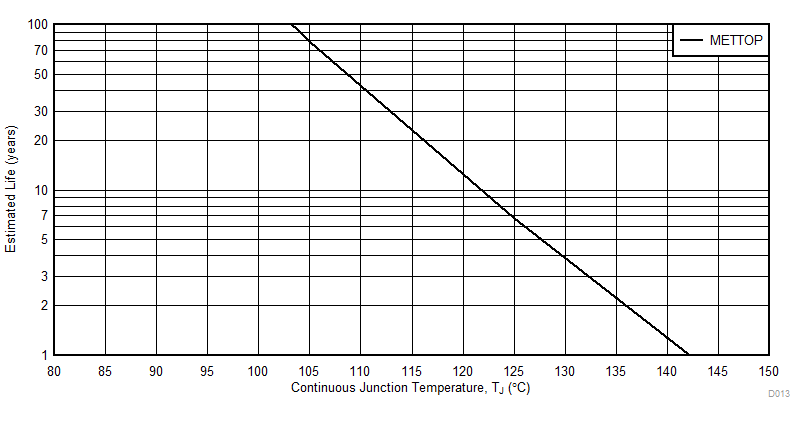
1. Electromigration fail mode = time at temperature with bias.
2. Silicon operating life design goal is 10 years at 105°C junction temperature (does not include package interconnect life).
3. The predicted operating lifetime versus junction temperature is based on reliability modeling and available qualification data.
Figure 1. Predicted Lifetime Derating Chart for TPS51200-EP
6.6 Typical Characteristics
3 × 10-µF MLCCs (0805) are used on the output.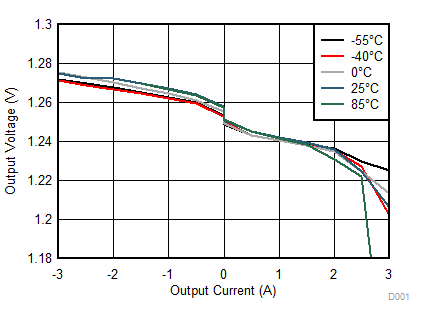
| VVIN = 3.3 V | DDR |
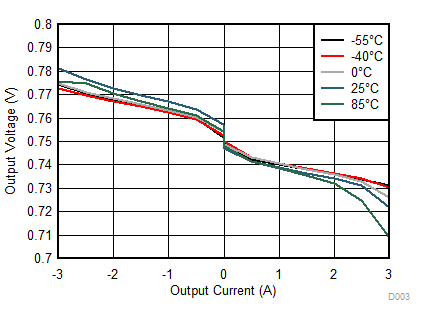
| VVIN = 3.3 V | DDR3 |
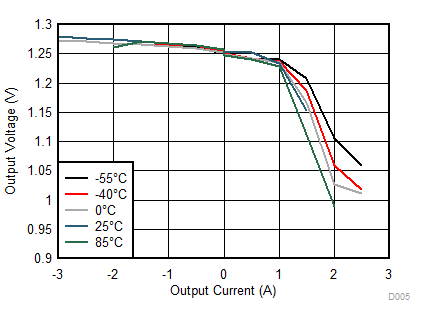
| VVIN = 2.5 V | DDR |
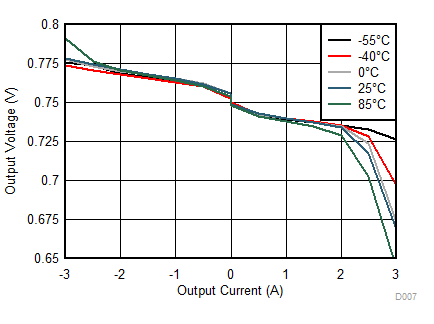
| VVIN = 2.5 V | DDR3 |
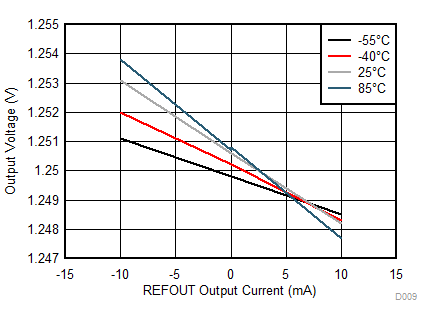
| DDR |
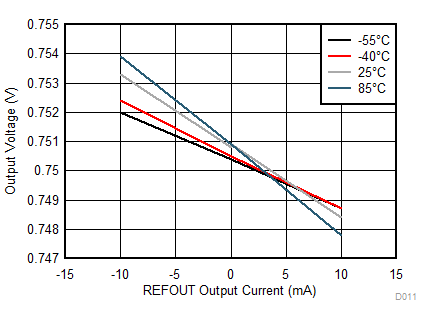
| DDR3 |
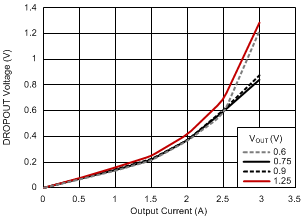
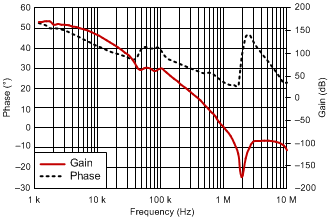
| DDR3 |
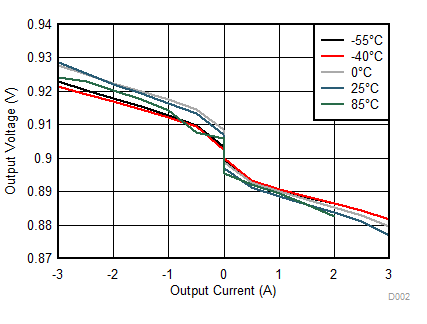
| VVIN = 3.3 V | DDR2 |
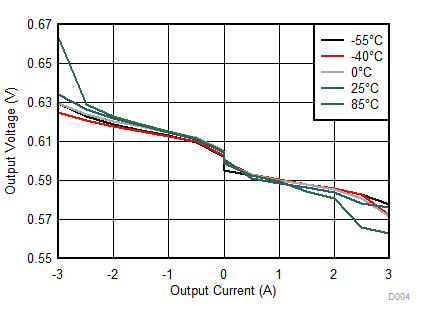
| VVIN = 3.3 V | LP DDR3 or DDR4 |
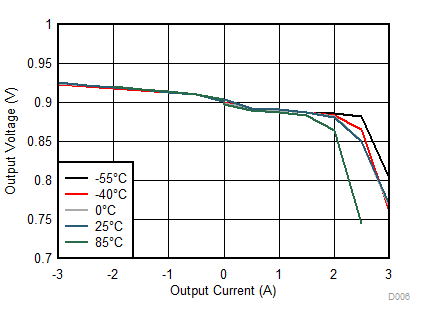
| VVIN = 2.5 V | DDR2 |
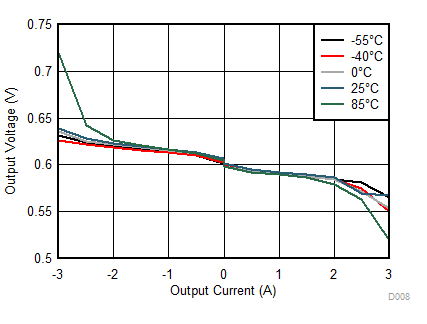
| VVIN = 2.5 V | LP DDR3 or DDR4 |
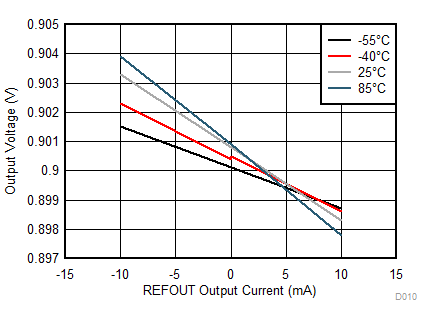
| DDR2 |
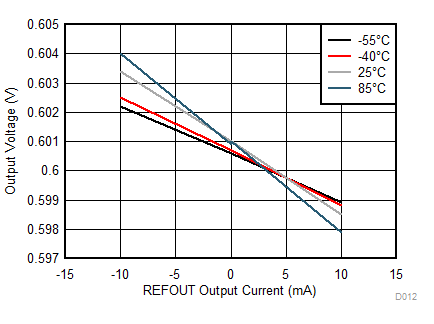
| LP DDR3 or DDR4 |
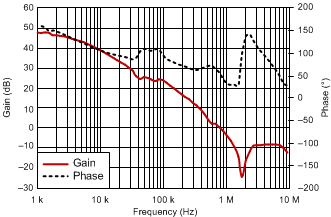
| DDR2 |